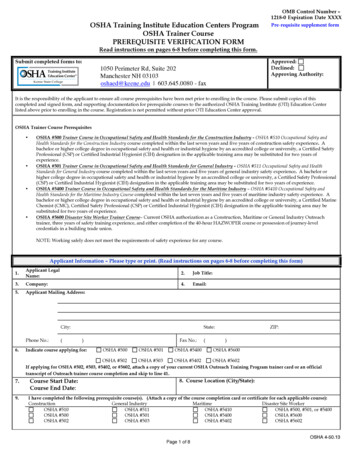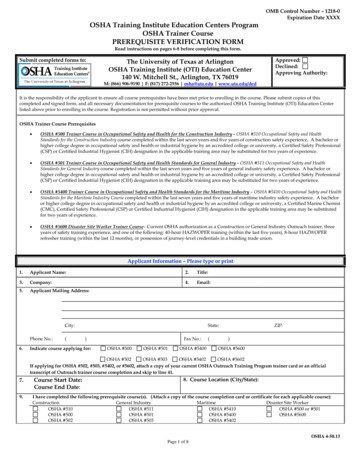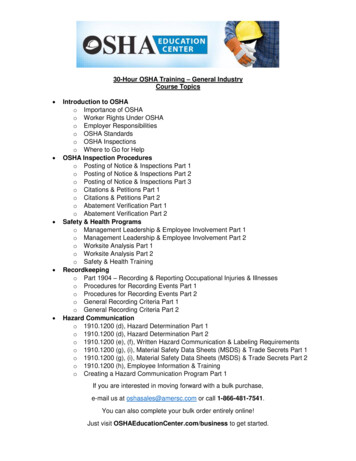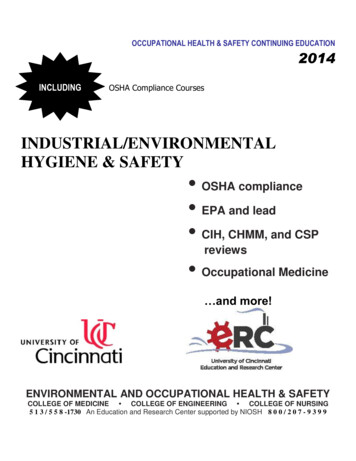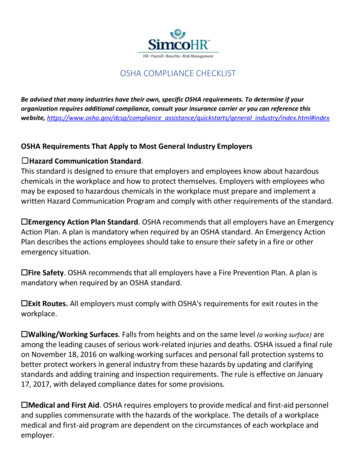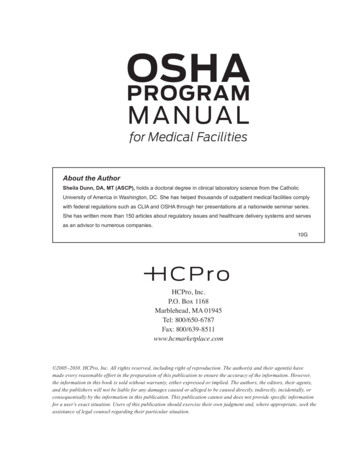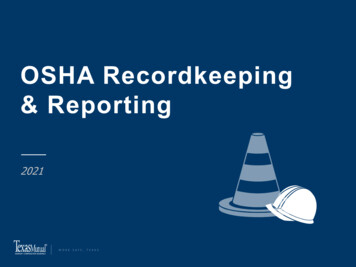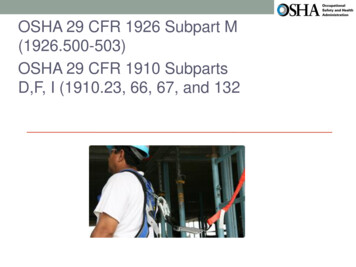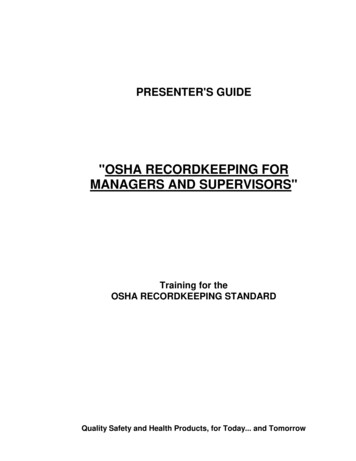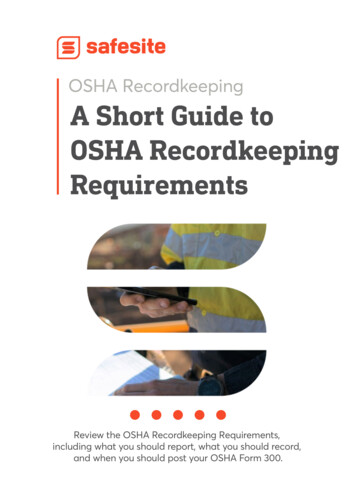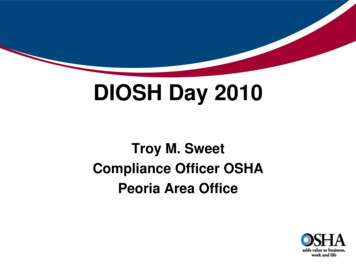
Transcription
Fall ProtectionCourse No: C03-002Credit: 3 PDHGilbert Gedeon, P.E.Continuing Education and Development, Inc.9 Greyridge Farm CourtStony Point, NY 10980P: (877) 322-5800F: (877) 322-4774info@cedengineering.com
Fall Protectionin ConstructionU.S. Department of LaborOccupational Safety and Health AdministrationOSHA 31461998(Revised)
This informational booklet isintended to provide a generic, nonexhaustive overview of a particularstandards-related topic. Thispublication does not itself alter ordetermine compliance responsibilities, which are set forth in OSHAstandards themselves, and theOccupational Safety and Health Act.Moreover, because interpretationsand enforcement policy may changeover time, for additional guidance onOSHA compliance requirements, thereader should consult currentadministrative interpretations anddecisions by the Occupational Safetyand Health Review Commission andthe courts.Material contained in this publication is in the public domain and maybe reproduced, fully or partially,without the permission of theFederal Government. Source creditis requested but not required.This information will be madeavailable to sensory impairedindividuals upon request.Voice Phone: (202) 219-8615;Telecommunications Device for theDeaf (TDD) message referral phone:1-800-326-2577.Fall Protection in Construction
Fall Protectionin ConstructionU.S. Department of LaborAlexis M. Herman, SecretaryOccupational Safety and Health AdministrationCharles N. Jeffress, Assistant SecretaryOSHA 31461998 (Revised)
ContentsiiiPageWhy Does OSHA Have a Standard for Fall Protection? . 1What Does the Fall Protection Standard Cover? . 2What Are the Requirements of the Standard? . 4Controlled Access Zones . 4Excavations . 6Fall Protection Systems Criteria and Practices . 6Covers . 6Guardrail Systems. 7Personal Fall Arrest Systems . 9Positioning Device Systems . 11Safety Monitoring Systems . 11Safety Net Systems . 12Warning Line Systems . 14Formwork and Reinforcing Steel . 15Hoist Areas . 15Holes . 15Leading Edges . 15Overhand Bricklaying and Related Work . 16Precast Concrete Erection . 16Protection From Falling Objects. 16Canopies . 17Toeboards. 17Training. 17Residential Construction . 18Ramps, Runways, and Other Walkways . 19Roofing . 19Low-Slope Roofs . 19Steep Roofs . 19Wall Openings . 19Contents
ivContents (Continued)PageWhat Other Help Can OSHA Provide? . 20Safety and Health Program Management Guidelines. 20State Programs . 20Free Onsite Consultation . 21Voluntary Protection Programs . 21Training and Education. 22Electronic Information . 22Emergencies . 23Glossary . 24Related OSHA Publications . 27States with Approved Plans . 28OSHA Consultation Project Directory . 32OSHA Area Offices . 34OSHA Regional Offices . 37Fall Protection in Construction
Why Does OSHA Have a Standard for Fall Protection?1In the construction industry in the U.S., falls are the leadingcause of worker fatalities. Each year, on average, between 150and 200 workers are killed and more than 100,000 are injuredas a result of falls at construction sites. OSHA recognizes thataccidents involving falls are generally complex events frequently involving a variety of factors. Consequently, thestandard for fall protection deals with both the human andequipment-related issues in protecting workers from fall hazards. For example, employers and employees need to do thefollowing: Where protection is required, select fall protectionsystems appropriate for given situations. Use proper construction and installation of safety systems. Supervise employees properly. Use safe work procedures. Train workers in the proper selection, use, andmaintenance of fall protection systems.Why Does OSHA Have a Standard for Fall Protection?
2What Does the Fall Protection Standard Cover?OSHA has revised its construction industry safety standards[Title 29 Code of Federal Regulations, Subpart M, Fall Protection, 1926.500(a), 1926.501, 1926.502, and 1926.503] anddeveloped systems and procedures designed to prevent employees from falling off, onto, or through working levels and toprotect employees from being struck by falling objects (Federal Register, August 9, 1994, pp. 40672-40753). The performance-oriented requirements make it easier for employers toprovide the necessary protection.The rule covers most construction workers except thoseinspecting, investigating, or assessing workplace conditionsprior to the actual start of work or after all work has beencompleted.The rule identifies areas or activities where fall protection isneeded. These include, but are not limited to, ramps, runways,and other walkways, excavations, hoist areas, holes, formworkand reinforcing steel, leading edge work, unprotected sides andedges, overhand bricklaying and related work, roofing work,precast concrete erection, wall openings, residential construction, and other walking/working surfaces. The rule sets auniform threshold height of 6 feet (1.8 meters), thereby providing consistent protection. This means that construction employers must protect their employees from fall hazards andfalling objects whenever an affected employee is 6 feet (1.8meters) or more above a lower level. Protection also must beprovided for construction workers who are exposed to thehazard of falling into dangerous equipment.Under the standard, employers are able to select fall protection measures compatible with the type of work being performed. Fall protection generally can be provided through theuse of guardrail systems, safety net systems, personal fall arrestsystems, positioning device systems, and warning line systems,among others.Fall Protection in Construction
3The OSHA rule clarifies what an employer must do toprovide fall protection for employees, such as identifying andevaluating fall hazards and providing specific training. Requirements to provide fall protection for workers on scaffoldsand ladders and for workers engaged in steel erection ofbuildings are covered in other subparts of OSHA regulations.What Does the Fall Protection Standard Cover?
4What Are the Requirements of the Standard?The standard prescribes the duty to provide fall protection,sets the criteria and practices for fall protection systems, andrequires training. It covers hazard assessment and fall protection and safety monitoring systems. Also addressed are controlled access zones, safety nets, and guardrail, personal fallarrest, warning line, and positioning device systems.Under 29 CFR Subpart M, Fall Protection, 1926.501, employers must assess the workplace to determine if the walkingor working surfaces on which employees are to work have thestrength and structural integrity to safely support workers.Employees are not permitted to work on those surfaces until ithas been determined that the surfaces have the requisitestrength and structural integrity to support the workers. Onceemployers have determined that the surface is safe for employees to work on, the employer must select one of the optionslisted for the work operation if a fall hazard is present.For example, if an employee is exposed to falling 6 feet (1.8meters) or more from an unprotected side or edge, the employer must select either a guardrail system, safety net system,or personal fall arrest system to protect the worker.Similar requirements are prescribed for other fall hazards asfollows:Controlled Access Zones - 1926.502(g)A controlled access zone is a work area designated andclearly marked in which certain types of work (such as overhand bricklaying) may take place without the use of conventional fall protection systems—guardrail, personal arrest orsafety net—to protect the employees working in the zone.Controlled access zones are used to keep out workers otherthan those authorized to enter work areas from which guardrails have been removed. Where there are no guardrails,masons are the only workers allowed in controlled accesszones.Fall Protection in Construction
5Controlled access zones, when created to limit entrance toareas where leading edge work and other operations are takingplace, must be defined by a control line or by any other meansthat restrict access. Control lines shall consist of ropes, wires,tapes or equivalent materials, and supporting stanchions, andeach must be: Flagged or otherwise clearly marked at not more than6-foot (1.8 meters) intervals with high-visibility material. Rigged and supported in such a way that the lowest point(including sag) is not less than 39 inches (1 meter) fromthe walking/working surface and the highest point is notmore than 45 inches (1.3 meters)—nor more than 50inches (1.3 meters) when overhand bricklaying operationsare being performed—from the walking/working surface. Strong enough to sustain stress of not less than 200pounds (0.88 kiloNewtons). Control lines shall extendalong the entire length of the unprotected or leading edgeand shall be approximately parallel to the unprotected orleading edge. Control lines also must be connected on each side to aguardrail system or wall.When control lines are used, they shall be erected not lessthan 6 feet (1.8 meters) nor more than 25 feet (7.6 meters) fromthe unprotected or leading edge, except when precast concretemembers are being erected. In the latter case, the control lineis to be erected not less than 6 feet (1.8 meters) nor more than60 feet (18 meters) or half the length of the member beingerected, whichever is less, from the leading edge.Controlled access zones when used to determine access toareas where overhand bricklaying and related work aretaking place are to be defined by a control line erected not lessthan 10 feet (3 meters) nor more than 15 feet (4.6 meters) fromthe working edge. Additional control lines must be erected atWhat Are the Requirements of the Standard?
6each end to enclose the controlled access zone. Only employees engaged in overhand bricklaying or related work arepermitted in the controlled access zones.On floors and roofs where guardrail systems are not in placeprior to the beginning of overhand bricklaying operations,controlled access zones must be enlarged as necessary toenclose all points of access, material handling areas, andstorage areas.On floors and roofs where guardrail systems are in place, butneed to be removed to allow overhand bricklaying work orleading edge work to take place, only that portion of the guardrail necessary to accomplish that day’s work shall be removed.Excavations - 1926.501(b)(7)Each employee at the edge of an excavation 6 feet(1.8 meters) or more deep shall be protected from falling byguardrail systems, fences, barricades, or covers. Where walkways are provided to permit employees to cross over excavations, guardrails are required on the walkway if the fall wouldbe 6 feet (1.8 meters) or more to the lower level.Fall Protection Systems Criteria and PracticesCovers - 1926.502(i)Covers located in roadways and vehicular aisles must beable to support at least twice the maximum axle load of thelargest vehicle to which the cover might be subjected. Allother covers must be able to support at least twice the weight ofemployees, equipment, and materials that may be imposed onthe cover at any one time. To prevent accidental displacementresulting from wind, equipment, or workers’ activities, allcovers must be secured. All covers shall be color coded or bearthe markings “HOLE” or “COVER.”Fall Protection in Construction
7Guardrail Systems - 1926.501(502(b)If the employer chooses to use guardrail systems to protectworkers from falls, the systems must meet the followingcriteria. Toprails and midrails of guardrail systems must be atleast one-quarter inch (0.6 centimeters) nominal diameter orthickness to prevent cuts and lacerations. If wire rope is usedfor toprails, it must be flagged at not more 6 feet intervals (1.8meters) with high-visibility material. Steel and plastic bandingcannot be used as toprails or midrails. Manila, plastic, orsynthetic rope used for toprails or midrails must be inspected asfrequently as necessary to ensure strength and stability.The top edge height of toprails, or (equivalent) guardrailsmust be 42 inches (1.1 meters) plus or minus 3 inches (8centimeters), above the walking/working level. When workersare using stilts, the top edge height of the top rail, or equivalentmember, must be increased an amount equal to the height ofthe stilts.Screens, midrails, mesh, intermediate vertical members, orequivalent intermediate structural members must be installedbetween the top edge of the guardrail system and the walking/working surface when there are no walls or parapet walls atleast 21 inches (53 centimeters) high. When midrails are used,they must be installed at a height midway between the top edgeof the guardrail system and the walking/working level. Whenscreens and mesh are used, they must extend from the top railto the walking/working level and along the entire openingbetween top rail supports. Intermediate members, such asbalusters, when used between posts, shall not be more than19 inches (48 centimeters) apart.Other structural members, such as additional midrails andarchitectural panels, shall be installed so that there are noopenings in the guardrail system more than 19 inches(48 centimeters).What Are the Requirements of the Standard?
8The guardrail system must be capable of withstanding aforce of at least 200 pounds (890 Newtons) applied within2 inches of the top edge in any outward or downward direction.When the 200 pounds (890 Newtons) test is applied in a downward direction, the top edge of the guardrail must not deflect toa height less than 39 inches (1 meter) above the walking/working level.Midrails, screens, mesh, intermediate vertical members,solid panels, and equivalent structural members shall be capable of withstanding a force of at least 150 pounds(666 Newtons) applied in any downward or outward directionat any point along the midrail or other member.Guardrail systems shall be surfaced to protect workers frompunctures or lacerations and to prevent clothing from snagging.The ends of top rails and midrails must not overhang terminal posts, except where such an overhang does not constitute aprojection hazard.When guardrail systems are used at hoisting areas, a chain,gate or removable guardrail section must be placed across theaccess opening between guardrail sections when hoistingoperations are not taking place.At holes, guardrail systems must be set up on all unprotectedsides or edges. When holes are used for the passage of materials, the hole shall have not more than two sides with removableguardrail sections. When the hole is not in use, it must becovered or provided with guardrails along all unprotected sidesor edges.If guardrail systems are used around holes that are used asaccess points (such as ladderways), gates must be used or thepoint of access must be offset to prevent accidental walkinginto the hole.If guardrails are used at unprotected sides or edges of rampsand runways, they must be erected on each unprotected side oredge.Fall Protection in Construction
9Personal Fall Arrest Systems - 1926.502(d)These consist of an anchorage, connectors, and a body beltor body harness and may include a deceleration device, lifeline,or suitable combinations. If a personal fall arrest system isused for fall protection, it must do the following: Limit maximum arresting force on an employee to 900pounds (4 kiloNewtons) when used with a body belt; Limit maximum arresting force on an employee to 1,800pounds (8 kiloNewtons) when used with a body harness; Be rigged so that an employee can neither free fall morethan 6 feet (1.8 meters) nor contact any lower level; Bring an employee to a complete stop and limit maximumdeceleration distance an employee travels to 3.5 feet(1.07 meters); and Have sufficient strength to withstand twice the potentialimpact energy of an employee free falling a distance of6 feet (1.8 meters) or the free fall distance permitted bythe system, whichever is less.The use of body belts for fall arrest is currently allowed, buteffective January 1, 1998, the use of a body belt for fall arrestwill be prohibited; however, the use of a body belt in apositioning device system is acceptable.Personal fall arrest systems must be inspected prior to eachuse for wear damage, and other deterioration. Defectivecomponents must be removed from service. Dee-rings andsnaphooks must have a minimum tensile strength of 5,000pounds (22.2 kiloNewtons). Dee-rings and snaphooks shall beproof-tested to a minimum tensile load of 3,600 pounds(16 kiloNewtons) without cracking, breaking, or sufferingpermanent deformation.Snaphooks shall be sized to be compatible with the memberto which they will be connected, or shall be of a lockingconfiguration.What Are the Requirements of the Standard?
10Unless the snaphook is a locking type and designed for thefollowing connections, they shall not be engaged (a) directly towebbing, rope, or wire rope; (b) to each other; (c) to a dee-ringto which another snaphook or other connecter is attached;(d) to a horizontal lifeline; or (e) to any object incompatible inshape or dimension relative to the snaphook, thereby causingthe connected object to depress the snaphook keeper andrelease unintentionally.OSHA considers a hook to be compatible when the diameterof the dee-ring to which the snaphook is attached is greaterthan the inside length of the snaphook when measured from thebottom (hinged end) of the snaphook keeper to the inside curveof the top of the snaphook. Thus, no matter how the dee-ring ispositioned or moved (rolls) with the snaphook attached, thedee-ring cannot touch the outside of the keeper, thus depressingit open. As of January 1, 1998, the use of nonlockingsnaphooks will be prohibited.On suspended scaffolds or similar work platforms withhorizontal lifelines that may become vertical lifelines, thedevices used to connect to a horizontal lifeline shall be capableof locking in both directions on the lifeline.Horizontal lifelines shall be designed, installed, and usedunder the supervision of a qualified person, as part of a complete personal fall arrest system that maintains a safety factorof at least two. Lifelines shall be protected against being cut orabraded.Self-retracting lifelines and lanyards that automatically limitfree fall distance to 2 feet (0.61 meters) or less shall be capableof sustaining a minimum tensile load of 3,000 pounds(13.3 kiloNewtons) applied to the device with the lifeline orlanyard in the fully extended position.Self-retracting lifelines and lanyards that do not limit freefall distance to 2 feet (0.61 meters) or less, ripstitch lanyards,and tearing and deforming lanyards shall be capable of sustainFall Protection in Construction
11ing a minimum tensile load of 5,000 pounds (22.2 kiloNewtons)applied to the device with the lifeline or lanyard in the fullyextended position.Ropes and straps (webbing) used in lanyards, lifelines, andstrength components of body belts and body harnesses shall bemade of synthetic fibers.Anchorages shall be designed, installed, and used under thesupervision of a qualified person, as part of a complete personalfall arrest system that maintains a safety factor of at least two, i.e.,capable of supporting at least twice the weight expected to beimposed upon it. Anchorages used to attach personal fall arrestsystems shall be independent of any anchorage being used tosupport or suspend platforms and must be capable of supporting atleast 5,000 pounds (22.2 kiloNewtons) per person attached.Lanyards and vertical lifelines must have a minimum breakingstrength of 5,000 pounds (22.2 kiloNewtons).Positioning Device Systems - 1926.502(e)These body belt or body harness systems are to be set up sothat a worker can free fall no farther than 2 feet (0.6 meters).They shall be secured to an anchorage capable of supporting atleast twice the potential impact load of an employee’s fall or3,000 pounds (13.3 kiloNewtons), whichever is greater. Requirements for snaphooks, dee-rings, and other connectors usedwith positioning device systems must meet the same criteria asthose for personal fall arrest systems.Safety Monitoring Systems - 1926.502(h)When no other alternative fall protection has been implemented, the employer shall implement a safety monitoringsystem. Employers must appoint a competent person toWhat Are the Requirements of the Standard?
12monitor the safety of workers and the employer shall ensurethat the safety monitor: Is competent in the recognition of fall hazards, Is capable of warning workers of fall hazard dangers andin detecting unsafe work practices, Is operating on the same walking/working surfaces of theworkers and can see them, and Is close enough to work operations to communicate orallywith workers and has no other duties to distract from themonitoring function.Mechanical equipment shall not be used or stored in areaswhere safety monitoring systems are being used to monitoremployees engaged in roofing operations on low-sloped roofs.No worker, other than one engaged in roofing work (on lowsloped roofs) or one covered by a fall protection plan, shall beallowed in an area where an employee is being protected by asafety monitoring system.All workers in a controlled access zone shall be instructed topromptly comply with fall hazard warnings issued by safetymonitors.Safety Net Systems - 1926.502(c)Safety nets must be installed as close as practicable underthe walking/working surface on which employees are workingand never more than 30 feet (9.1 meters) below such levels.Defective nets shall not be used. Safety nets shall be inspectedat least once a week for wear, damage, and other deterioration.The maximum size of each safety net mesh opening shall notexceed 36 square inches (230 square centimeters) nor be longerthan 6 inches (15 centimeters) on any side, and the openings,measured center-to-center, of mesh ropes or webbing, shall notexceed 6 inches (15 centimeters). All mesh crossings shall beFall Protection in Construction
13secured to prevent enlargement of the mesh opening.Each safety net or section shall have a border rope for webbingwith a minimum breaking strength of 5,000 pounds(22.2 kiloNewtons). Connections between safety net panelsshall be as strong as integral net components and be spaced nomore than 6 inches (15 centimeters) apart.Safety nets shall be installed with sufficient clearance underneath to prevent contact with the surface or structure below.When nets are used on bridges, the potential fall area fromthe walking/working surface to the net shall be unobstructed.Safety nets must extend outward from the outermostprojection of the work surface as follows:Vertical distancefrom working levelto horizontal planeof net surface.Minimum requiredhorizontal distanceof outer edge of netfrom edge of working surface.Up to 5 feet (1.5 meters)More than 5 feet (1.5 meters)up to 10 feet (3 meters)More than 10 feet (3 meters)8 feet (2.4 meters)10 feet (3 meters)13 feet (3.9 meters)Safety nets shall be capable of absorbing an impact force ofa drop test consisting of a 400-pound (180 kilograms) bag ofsand 30 inches (76 centimeters) in diameter dropped from thehighest walking/working surface at which workers are exposed,but not from less than 42 inches (1.1 meters) above that level.Items that have fallen into safety nets including—but notrestricted to, materials, scrap, equipment, and tools—must beremoved as soon as possible and at least before the next workshift.What Are the Requirements of the Standard?
14Warning Line Systems - 1926.502(f)Warning line systems consist of ropes, wires, or chains, andsupporting stanchions and are set up as follows: Flagged at not more than 6-foot (1.8 meters) intervals withhigh-visibility material. Rigged and supported so that the lowest point includingsag is no less than 34 inches (0.9 meters) from the walking/working surface and its highest point is no more than39 inches (1 meter) from the walking/working surface. Stanchions, after being rigged with warning lines, shall becapable of resisting, without tipping over, a force of atleast 16 pounds (71 Newtons) applied horizontally againstthe stanchion, 30 inches (0.8 meters) above the walking/working surface, perpendicular to the warning line andin the direction of the floor, roof, or platform edge. The rope, wire, or chain shall have a minimum tensilestrength of 500 pounds (2.22 kiloNewtons), and afterbeing attached to the stanchions, must support withoutbreaking the load applied to the stanchions as prescribedabove. Shall be attached to each stanchion in such a way thatpulling on one section of the line between stanchions willnot result in slack being taken up in the adjacent sectionbefore the stanchion tips over.Warning lines shall be erected around all sides of roof workareas. When mechanical equipment is being used, the warningline shall be erected not less than 6 feet (1.8 meters) from theroof edge parallel to the direction of mechanical equipmentoperation, and not less than 10 feet (3 meters) from the roofedge perpendicular to the direction of mechanical equipmentoperation.When mechanical equipment is not being used, the warningline must be erected not less than 6 feet (1.8 meters) from theroof edge.Fall Protection in Construction
15Formwork and Reinforcing Steel - 1926.501(b)(5)For employees, while moving vertically and/or horizontallyon the vertical face of rebar assemblies built in place, fallprotection is not required when employees are moving. OSHAconsiders the multiple hand holds and foot holds on rebarassemblies as providing similar protection as that provided by afixed ladder. Consequently, no fall protection is necessarywhile moving point to point for heights below 24 feet(7.3 meters). An employee must be provided with fall protection when climbing or otherwise moving at a height more than24 feet (7.3 meters), the same as for fixed ladders.Hoist Areas - 1926.501(b)(3)Each employee in a hoist area shall be protected from falling6 feet (1.8 meters) or more by guardrail systems or personalfall arrest systems. If guardrail systems (or chain gate orguardrail) or portions thereof must be removed to facilitatehoisting operations, as during the landing of materials, and aworker must lean through the access opening or out over theedge of the access opening to receive or guide equipment andmaterials, that employee must be protected by a personal fallarrest system.Holes - 1926.501(b)(4)Personal fall arrest systems, covers, or guardrail systemsshall be erected around holes (including skylights) that aremore than 6 feet (1.8 meters) above lower levels.Leading Edges - 1926.501(b)(2)Each employee who is constructing a leading edge 6 feet(1.8 meters) or more above lower levels shall be protected byguardrail systems, safety net systems, or personal fall arrestsystems. If the employer can demonstrate that it is infeasibleWhat Are the Requirements of the Standard?
16or creates a greater hazard to implement these systems, he orshe must develop and implement a fall protection plan thatmeets the requirements of 29 CFR 1926.502(k).Overhand Bricklaying and Related Work - 1926.501(b)(9)Each employee performing overhand bricklaying and relatedwork 6 feet (1.8 meters) or more above lower levels shall beprotected by guardrail systems, safety net systems, or personalfall arrest systems, or shall work in a controlled access zone.All employees reaching more than 10 inches (25 centimeters)below the level of a walking/working surface on which they areworking shall be protected by a guardrail system, safety netsystem, or personal fall arrest system.Precast Concrete Erection - 1926.501(b)(12)Each employee who is 6 feet (1.8 meters) or more abovelower levels while erecting precast concrete members andrelated operations such as grouting of precast concrete members shall be protected by guardrail systems, safety net systems, or personal fall arrest systems. Where the employer candemonstrate, however, that it is in
[Title 29 Code of Federal Regulations, Subpart M, Fall Protec-tion, 1926.500(a), 1926.501, 1926.502, and 1926.503] and developed systems and procedures designed to prevent em-ployees from falling off, onto, or through working levels and to protect employees from being struck by falling objects (Fed-eral Register, August 9, 1994, pp. 40672-40753).
